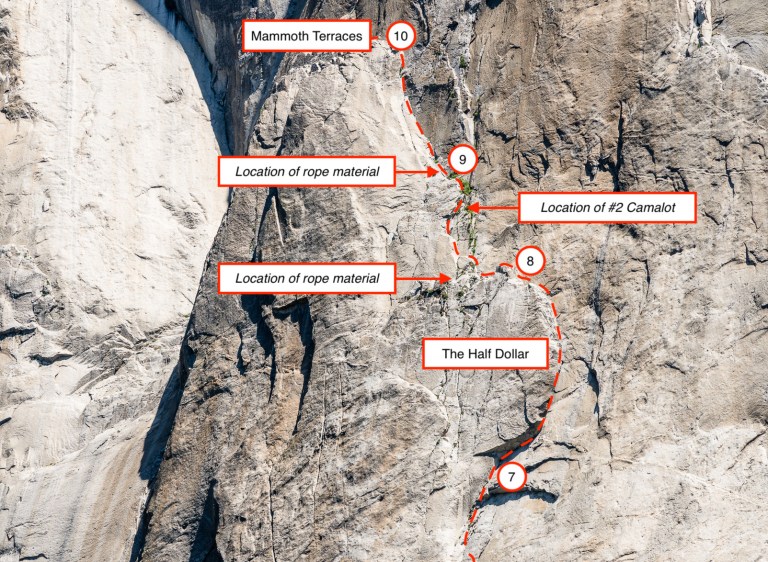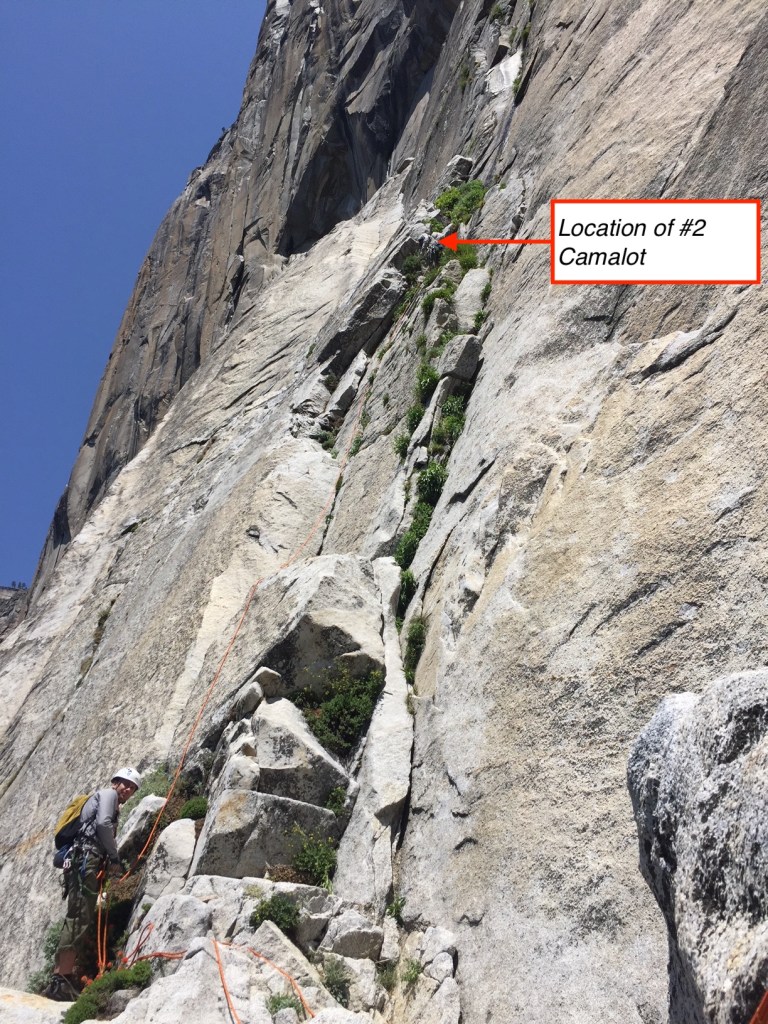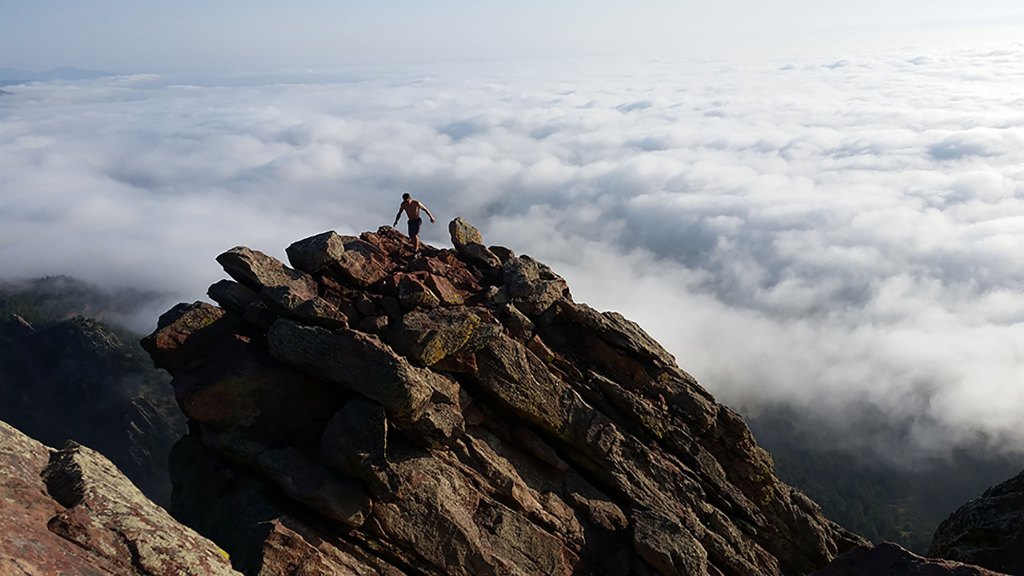In the early hours of Sunday, May 13, 2018, Jason Wells, 45, and Tim Klein, 42, headed up the Nose (VI 5.9 C2) on El Capitan in Yosemite National Park. They moved fast and placed little gear; Wells and Klein, friends and climbing partners, had nearly 200 El Capitan ascents between them. They had even done the 2,900-foot route the day before. What set this particular ascent apart was the notable party climbing above them.
Alex Honnold and Tommy Caldwell were also on El Capitan that day, running their first practice lap together on the Nose in an effort to break the speed record of 2 hours, 19 minutes and 44 seconds set by Jim Reynolds and Brad Gobright in 2017. Photographer Austin Siadak sat on Dolt Tower, about 1,000 feet up the route, filming Caldwell and Honnold above him as they climbed past Texas Flake and on to Boot Flake.
Suddenly, Siadak heard sounds coming from below. When he leaned over the edge and saw two climbers quickly approaching Dolt Tower, he was surprised. The oncoming team had started after Caldwell and Honnold, but these new guys were keeping pace with the best big wall speed climbers in the world.
Who the hell are these guys? Siadak thought. Just then, Wells popped over the lip.
Oh, of course, it’s Jason.
Siadak says they had met a few weeks prior while climbing in the Flatirons near Wells’ home in Boulder, Colorado. They said hello. Siadak says Wells was breathing heavily, but he appeared relaxed and happy, blasting death metal from a small speaker on his harness. Klein joined them on the ledge, and the trio exchanged pleasantries, discussing the weather and how Honnold and Caldwell were doing above.
“You guys better pick it up,” Siadak yelled up to Honnold. “These guys might catch you!”
That day, on their first time trying the route together during the record-breaking attempts, Alex Honnold and Tommy Caldwell would climb the Nose in about 4 and a half hours. According to Wells’ and Klein’s friend and longtime climbing partner Stefan Griebel, Wells and Klein, both fathers and husbands with full-time jobs, would climb it in about 5 and a half hours.
Only a few weeks later, on June 2, Wells and Klein were back in the Yosemite Valley, going for another round of two El Cap laps in two days. This time, they were on the 10-pitch Freeblast portion of the Salathé Wall with a third climber, Kevin Prince. With the goal of making an in-a-day ascent, the trio was employing an advanced time-saving technique called short-fixing, according to an accident report released by the Yosemite climbing rangers. Although speed climbers often use this technique, a speed record was not the group’s goal. Wells would lead a pitch, pull up slack, attach (or fix) the rope to a piece of protection, and keep climbing either without a belay or with a self-belay on his portion of the rope. Klein, who was tied into the other end of Wells’ rope, would then ascend the fixed rope, and when he arrived at the anchor, he would put Wells back on a standard belay, the report says. Since they were a team of three, Klein was tagging up a second rope, which he would fix at each anchor so Prince could rope-solo behind them.
The team had reached the final pitches of the route by around 8am, with Wells leading the ledge-filled section (graded 5.7 and easier) leading to Mammoth Terraces (top of pitch 10). At 8:05am, Klein yelled to Prince that his rope was fixed, so Prince began climbing the 5.10 chimney known as the Half Dollar (pitch 8), which put him out of sight of Wells and Klein, the report indicates.

Photo Credit: NPS
Although it’s not clear exactly what happened next, an eyewitness who was below the Half Dollar at the pitch 7 anchor reported seeing Wells mid-fall. The climber heard Klein yell, and then saw him mid-fall before both Wells and Klein hit the wall and stopped briefly. The rope then severed, and both men fell approximately 1,000 feet to the Valley floor.
In the days following the accident, early reports offered more questions than answers, fueling speculation within the climbing community. Initially, there were conflicting reports around the climbers’ intentions and the types of tactics they’d been employing. Some claimed to have seen a haul bag falling or rockfall, but the investigation found this to be incorrect.
“Both Jason [Wells] and Tim [Klein] and hundreds of other people any day of the week would just have waltzed up that section,” Griebel says about the climbing difficulty. “Something happened that we’ll never know.” The report also acknowledges that there are still many unknowns in the accident.
In describing the findings at the scene, investigators made note of the placement of a #2 Camalot. Klein had fixed Prince’s rope to the two-bolt anchor at the top of the Half Dollar pitch, but instead of staying connected to the end of Prince’s rope like he had done on every other pitch, Klein had attached the end to a #2 Camalot with a locking carabiner. Investigators say the cam was not at a significant ledge and determined it was a temporary placement.

Photo Credit: NPS
According to the accident report, this suggests that Klein might have had to move up or down on the wall for an unknown reason. “It is also possible that Wells and Klein met at the top of pitch 8, and Wells may have carried Prince’s rope to fix at the location of the #2 Camalot. Wells was likely combining pitches 9 and 10 into a single pitch, avoiding a gear anchor at the top of pitch 9,” the report states. “By doing this Klein would not have had enough rope to stay at the two-bolt anchor at the top of the Half Dollar. It was determined by investigators that a 60-meter rope would reach the bolted anchor atop Mammoth Terraces from the location of the #2 Camalot.”
Rope fibers were found about 40 feet above the cam, located on either side of a rock, which suggests that the rope might have severed there. More rope fibers were also found in boulders about 40 feet below the cam. No gear was found on the route, but because the rope severed, investigators say it’s possible that gear was placed, failed and then slid off the end of the rope.
***
The deaths of the climbers occurred against a backdrop of media focused on El Cap, as Honnold and Caldwell completed their first speed record ascent of the Nose in 2 hours, 10 minutes and 15 seconds on May 30, bettering Reynolds’ and Gobright’s record by nearly 10 minutes. Now, Honnold and Caldwell were looking to scale the monolith in less than two hours.
Wells and Klein’s accident, “made me question the whole thing—as it should,” Caldwell says.
Upon returning to the Nose the day after the accident, Caldwell says, “The original plan was to do a really fast lap, but instead we decided to really slow it down and analyze everything again. We wanted to make sure it felt fully within reason, to make sure that we could do it safely.”
The June activity in Yosemite came on the heels of two other accidents on the Nose. On May 3, famed speed climber Hans Florine fell and broke bones in his left ankle and right heel when a nut popped while he was aid climbing. On October 11, 2017, Quinn Brett, who held the women’s speed record on the Nose set in 2012, became paralyzed from the waist down when she fell 100 feet while attempting the Nose in a day.
“For [Wells and Klein], they weren’t really speed climbing,” says Becky Wells, Jason Wells’ wife. “That was the normal thing they did; they were so technically skilled and super-savvy and had been on the Salathé 20 or 30 times. We could always say that someone could be safer, but we all take risks.” Becky, who met Wells in a climbing training group at their local gym, had been on the Nose with her husband and Klein in the same three-person fashion. “They were very thoughtful, knew the exact pieces they were taking and had everything planned out. They were just moving, and they loved it. They took calculated risks, but something happened. I don’t have the answer.”
Despite the tragedy, Becky still says she would never tell Wells not to go to Yosemite and do what he loved.
“Jason would come back from Yosemite a better person. He called El Cap the Magic Stone, and for him, it was the Magic Stone,” she says. “It gave him what he needed to be the person he wanted to be in life. It fed his soul.”
Beyond being accomplished climbers, Klein and Wells were known for inspiring others around them, and they each had their own style of doing it. A thread on the climber forum SuperTopo has countless tales of Klein and Wells’ interactions with people on El Cap and beyond. Yosemite big wall climber Alix Morris ran into the duo almost every year, and it marked her own growth as a climber. She writes:
First, it was climbing the Salathé Wall for the first time in 2013. As a wide-eyed noob, I was in disbelief with their amazing athletic abilities, stamina and lighthearted approach to climbing something so ungodly in a day.
As I progressed in climbing, I returned again, to the base of Freeblast, eager to make the first all-female one-day Salathe ascent. At 4:30am, we were not the first to the base. Tim and Jason were. We didn’t even try [to] jockey in front of them. I remembered that laughter and ease as each pitch seemed to melt away below their feet. Other teams queued in behind us, and before their take off, we all had a dance party.
Again, in 2016, before an attempt on Freerider, we found them at the base … antsy to get a quick romp before returning to families and careers.
Last fall, at another pre-dawn start to my attempt at Freerider in a day, I found them encapsulated with the same joy children have. No contest for who went first! Even though I continued to push myself every year, I was no contender for those two. This time, I was scared of such an outing, but they assured me that there were no bad days on El Capitan. Within a few minutes of starting the route, they were both off the ground, moving fluidly through the bottom third of the wall. By the time we reached the slabs, they were nearing the monster. I was always in awe of those two. …
Griebel, who started climbing with Wells 10 years ago in Colorado, credits Klein and Wells with some of his biggest accomplishments. Griebel and Wells currently hold the round-trip speed record on Colorado’s 650-foot Naked Edge with a time of 24 minutes, 29 seconds. The first time Griebel met Klein, they climbed El Cap twice in a weekend. “The most fun I’ve had climbing was when we were hitting the Edge,” Griebel says. “It was so gratifying, so fun, so perspective-changing every single time. Both those guys were always so excited for you to push yourself, and for them to be right there with you.”

Scrambling in the Flatirons with Jason Wells above the clouds. (Photo Credit: Stefan Griebel)
Klein and Wells were equally connected—on and off the rock. They were good together, Becky says, and good for each other. “It was a brotherly love. They shared their passions and life. Tim exemplified a lot of things that people would like to be, and Tim would say the same of Jason.” When Klein won teacher of the year at Palmdale High School prior to the accident, Wells flew out to see Klein get his award. Wells was also there when Klein broke the Guinness Book of World Records for fastest time climbing the height of Everest on an indoor climbing wall in 9 hours, 26 minutes, 15 seconds. When Becky and Wells got married in June 2016, Klein officiated at their wedding.
***
The day after the accident, Honnold and Caldwell were back on the Nose, this time with the intention of going slow and seeing how the accident might have affected their mental approach. On June 4—two days after the accident—Caldwell and Honnold broke their own Nose speed record with a time of 2 hours, 1 minute, 53 seconds, and then again on June 6 in 1 hour, 58 minutes, 7 seconds.
Although some people might view these speed attempts so close to the accidents as callus, Griebel says nobody would have been more psyched for Honnold and Caldwell than Wells and Klein.
“Jason and Tim would have been up there whooping and hollering,” Griebel says. “Not many people get it, going up El Cap like that, just moving, motoring up and being efficient. It’s just so much fun.”
Becky agrees, pointing to Klein and Wells’ psych for other people as one of their greatest strengths. “I just want everyone to know what good guys they were—amazing souls who had a lot of love for people, for their wives and children,” she says. “It’s an unfortunate tragedy that ended their lives too soon. They both had a lot left to give to the world.”
